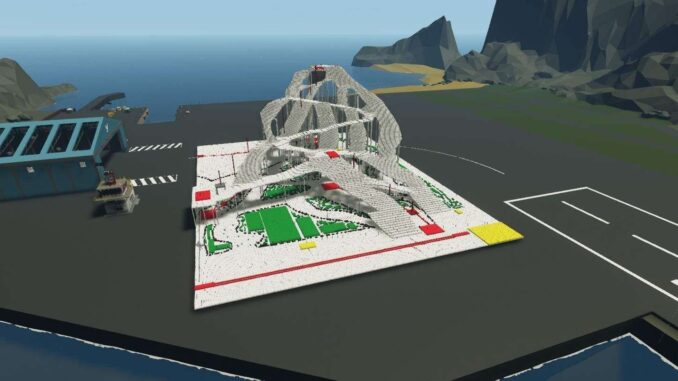
A continuation guide to Gearboxes and you, aiming to give pointers how to design effective engines for most situations!
Stormworks: Build and Rescue – Comprehensive Gearboxe Guide
A guide to Gearboxes, both simple and advanced. Has a simple follow-along tutorial for basics. Engine section moved to a separate guide Aims to answer nearly any question from whether or not you can make your boat go faster, or whether you can engineer a clockwork secretary that does your taxes.
Guide to Understand Gearboxes and You
Intro
So, gearboxes. We all want to have them, but sometimes they won’t reciprocate our affection. They confuse us, they infuriate us, and they, worst of all, don’t even have a personality. The guide will seek to have stupid dad-tier humor nonsense snuck in here and there to try hardest not to bore the reader.
If you do not know what a gearbox is, what it does, what it’s for, and are generally completely confused by the entire concept… the absolute best and most well explained video i have found that explains the private life of gearboxes anywhere is from the 1930’s and is found right there:
It is not required viewing if you already have an inkling, but i find the video entertaining regardless, and recommend watching it for that alone!
Super Simple and Short Explanation
These points are expanded upon far more in the guide that follows, this is just to give a bite-size information on what a gearbox does. If you’re not looking for just a bite-size summary but want the full dive, i recommend skipping this part, as it’s intended to just be short and extremely simple explanation.
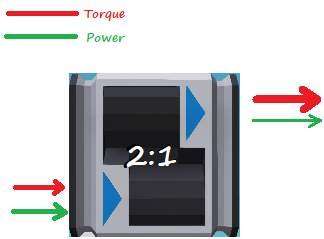
Engines provide 2 different things, rotations(power) and torque. Torque is the strength that the rotations are given out with. The gearbox has 2 values in it, the top value is when the signal going to the gearbox is off, and the bottom value is for when the value is on, allowing you to change gears.
A gearbox trades between power and torque 2 values. If you want twice the amount of rotations, you must give half of your torque, and the same is true the other way around. A powerful starting gear in a car for instance is something like 3:1, which means for every 3 rotations the engine makes, the wheels rotate once. They do this at 3 times the strength, which means it’s easy for the car to move.
The arrows (or rather, triangles) on the gearbox can be imagined like they’re “filled in” greater than / lesser than signs. If the triangle’s point is pointing toward the engine, so that for example engine < propeller, any values in the gearbox rise the amount of rotations behind it. Gearboxes count their values multiplicatively, so 2 1:3 gearboxes in a row becomes 1:9.
When the values of the gearboxes grow high rotation wise, the engine may struggle to provide enough torque to keep turning the driveshaft (power piping in game) and it will stall (fall below 2 RPS), this causes the engine to shut itself off and provide no power.
Gearbox Basics
So what is a gearbox?
At most simply, a gearbox can be imagined as a trade of potential. What does this mean?
First, there is something you must understand of power delivery (engines themselves are examined more in next section): Engines deliver 2 specific things, power and torque.
Power is the engine’s ability to spin the driveshaft at speed. The more power the engine has, the more rotations it can put out on the driveshaft.
Torque is the engine’s brute strength. If the driveshaft has resistance (like the work needed to turn a wheel) torque is the measurement of the engine’s ability to make it move.
This can be easily explained by some fantastic MS Paint art (watch out Monét).

As seen in the incredible artistic representation, the torque required to push a box uphill is far greater than the need for power which remains constant. Let’s assign some magic numbers and make some mental images.
These examples are extremely simple and do not use real units, other than distance and time, for simplicity’s sake
- It takes 1 unit of power and 1 unit of torque to push the box at 1 m/s.
- If we’re limited to 1 unit of power, and increase to 10 units of torque, we still can’t push the box faster than 1m/s, but it takes way less effort to do so, and we reach that speed much faster.
- If we have 4 units of power, and 1 unit of torque, we can push the box at 4m/s.
Uphill
- If we have 1 unit of power and 1 unit of torque, we can’t push the box.
- If we have 1 unit of power and 2 units of torque, we can just barely get the box moving, we’ll probably eventually reach 1m/s speed.
- If we have 2 units of power and 10 units of torque, we can easily reach 2m/s even uphill.
Now That I Understand That, What Do Gearboxes Do?
As said in the beginning, a gearbox is a trader.
If we have an engine that produces 10 power and 10 torque, a gearbox with the ratio of 2:1 would give you 5 power and 20 torque, while 1:2 would provide you with 20 power and 5 torque… well, in a perfect world. Unfortunately the trader wants a commission. The gearbox is only 95% efficient, so instead of 100% of the values coming through, we only get 95%, which is still pretty good, though!
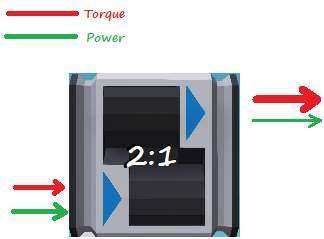
Gearboxes are multiplicative as well.
Let’s say you have 3 gearboxes in a row, each at 1:2. You will have a gearbox ratio of 1:8. Why? 1:2 * 1:2 = 1:4 —-> 1:4 * 1:2 = 1:8. Note that the penalties are multiplicative as well. Each gearbox reduces what you get out by 95%. Handling this is detailed later.
Wait, What the Hell Are These Ratios?! I Was Never Taught This!
You w0t m8?
Right, at least they are pretty simple to explain concisely.

The left value always refers to what the incoming power source (usually engine) is doing and the ratios only refer to the rotations made by the driveshaft. The driveshaft is the thing that the engine is rotating (power pipes represent it in the game). A 1:2 ratio gearbox will spin the driveshaft after it twice as fast, but only with half the strength.
And finally, those arrows on the gearboxes (see image of gearbox above).
When the arrows are pointing away from the power source the torque is being increased by the ratios, giving you ratios like 3:1, 2:1, 5:3, and 3:2.
When the arrows are pointing at the power source your power is being increased, giving you ratios like 1:3, 1:2, 3:5, and 2:3.
Keep in mind that the in-game ratios are always represented one way, and they are not changed in the UI depending on which way the gearbox is facing.
Now you should have a pretty good understanding of what the gearboxes do. In this game, unlike normal gearboxes, the gearboxes only have 2 ratios, and a switch between them. This means that the gearboxes will be quite a bit larger than their real life counterparts, but in trade they also weigh a lot less.
Engines and Gearboxes, a Match Made in Heaven?
Let’s talk a little bit about engines and more specifically how they intermingle with gearboxes, because you’ll be using gearboxes with engines most of the time.
Please note: Electric motors do not get any benefit from gearboxes. This is because of how electric motors drive themselves. They always put out maximum power and limit the amount of power coming out by the stress they’re under (that is, by required torque).
Engines have 3 very specific attributes that gearboxes can affect: RPS, Torque and Fuel consumption. Although more accurately load affects the RPS rate which reduces the fuel consumption, but more on that later.

On the foreground, the bottom 4 values are torque, and above them we can find the RPS. Above and behind are the engine’s own stats, the topmost is fuel consumption per minute, the red is RPS and the yellow is the temperature. The engine assembly is huge because i’ve tuned a small engine to put out 30 RPS without bursting in fire.
From left to right we have the following gear ratios: 1:9, 1:2, 2:1 and 1:1 (without gearbox).

Let’s examine them in order. They will not yet be affecting the engine much, because the gearboxes themselves or the torque meters do not apply any notable load. The throttle will always be stuck to 100% in these tests.
As expected, the 1:9 ratio is outputting an insane amount of RPS, but the torque value is so little you could probably stop it with your hand. Note that there’s some variability in these values because the engine is hitting its RPS limit so the RPS is bouncing around a little. The torque value, however, is stable, and it’s easy to see the potential efficiency loss on both 1:2 and 2:1.
Let’s introduce load by sticking wheels on every one of these (the wheel on the 1:1 is still 3×3, i just took this screenshot before i noticed the oops).
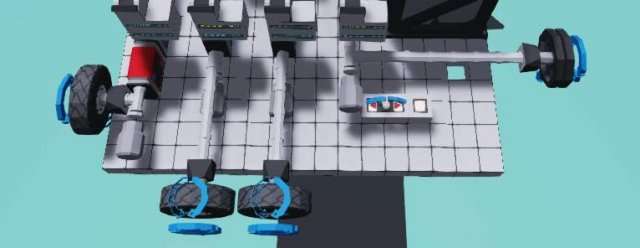
And let’s try that again.
These images will be:
- Only on the first, leftmost image: Before being turned on (this is same for all).
- Left (middle on the first): Immediately after being turned on.
- Right: Once it reaches full speed.
1:9

Now, we had something interesting happen. You notice that the torque values are way higher than rolling it freely. This is because the wheel itself is rotating, and providing torque to the torque meter.
Turning the clutch on very nearly killed the engine, and caused it to cool significantly (and quickly), and it began to spin up the wheel. Note the miniscule fuel consumption in comparison.
Once we reach the full speed in little over a minute, we have reached an effect that’s referred to as a flywheel. This is a pretty interesting little trick you can use in various designs and it’s even pretty common in real life applications.
The quickly rotating wheel is providing a good amount of torque (even more than the engine!), it’s taking very little engine power to run, and it can be used to push its gathered energy onto something. With 12 torque units and 268 RPS, we have more power at our disposal than 8 small engines can provide, but it’s very limited, as any power we pull from the flywheel reduces its RPS. Also note that the engine is using way less fuel to keep this thing in motion.
1:2
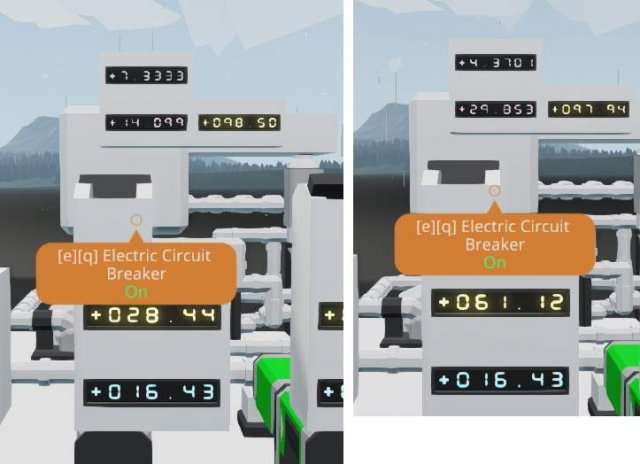
With this test and the previous wheel-less test we can determine the spinning 3×3 wheel is providing about 11.47 units of torque. (see the 1:9 image as to where i’m getting this value) We see the engine dip (although the fuel consumption calculator didn’t catch the fuel usage dip, it only updates once every 2 seconds). We can yet again see that the running wheel uses less fuel.
2:1
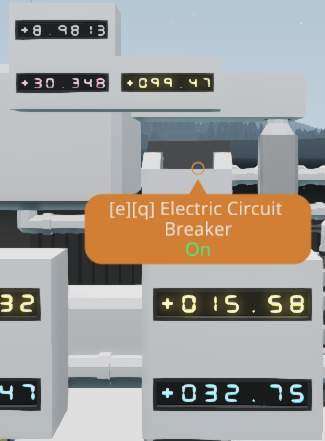
As you can tell there is only one image here. The reason is that turning this wheel does not stress the engine in any immediately obvious way, because it is expending only one quarter of the strength it would need to turn the 1:2 wheel.This is why gears like this are either used to move heavy loads or as starting gears in cars.
The wheel is still providing the 11.47 torque value as determined before, so it’s not just a weird quirk of the sensors.
“But wait, the fuel usage goes up? Why is that?” you may be wondering. Well, the wheels lose speed over time, they do this faster at faster speeds, and 15RPS is relatively fast. Now, the engine’s driveshaft has to make 2 rotations to impart one rotation to the wheel. This means that the engine is actually working notably more than it would when idle, and instead of running at 30 RPS, it’s now doing the work that an about 33RPS engine would to supply power to the wheel as well. This happens even with the limiter in place, even if the readout isn’t apparent.
1:1

The hitch in the engine is notable here, but lasts less than half a second, way too short to get a good, quick screenshot of it.
We get an interesting effect here once again, the flywheel effect. The engine’s fuel consumption goes down significantly because the wheel is requiring very little power input from the engine to turn, while the wheel itself is turning to keep the driveshaft rolling. This means that the engine doesn’t actually have to work as much which despite not lowering the torque or RPS, reduces the fuel consumption significantly.
Now, note that these are free-wheeling examples. They are special scenarios where the load itself can also impart energy back into the system. They are indicative of a lot of things, but don’t expect you can get better fuel economy just because you have a big honking flywheel. (though you might get a stuck/struggling vehicle to run with it).
Let’s now make sure the work doesn’t go back into the system
I will replace the 1:9 and 1:2 wheels with small generators. These are loads that cannot impart energy back into the system (at least significantly) like wheels (working as flywheels) can. I will also be changing the 1:2 into 1:3.
The starting point is the same, let’s see the results.
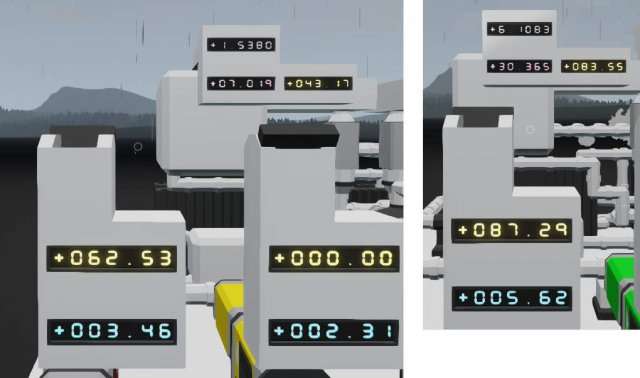
Fuel economy? Fuel economy.
On the left we have 1:9 and on the right we have 1:3. Now that we’re stressing the engine strongly, note that the fuel consumption has dropped heavily, but we’re still using the full potential of the engine.
In here, i am using the 1:3 example of the engine not using its full potential to work the load, which causes a significant fuel drain and forces the engine to hit the RPS cap. Essentially around 8 RPS is what you’re looking for at a cruise/constant load for a small engine, so this is about perfect for what you want your small engines to be. The peak power / consumption is different for the medium and large engines, but it’s better handled by an actual engine tutorial.
That should get you a decent idea of how gearboxes and engines work together. If you want to toy around with the setup yourself, here’s a workshop link on the last version of this with the generators.
Gearbox Tutorial Introduction
You should probably understand the absolute basics of how an engine works in this game in advanced mode before continuing. If you are unfamiliar with the engines’ inner workings, see the sections above.
We’ve all been there. You’ve spent hours and hours and finally you have crafted the finest, most exquisite vehicle in the land but have no idea why it’s going so slow, eating 1 liter of fuel for each and every single meter you crawl forward, and it’s making an absolute racket while being on fire!
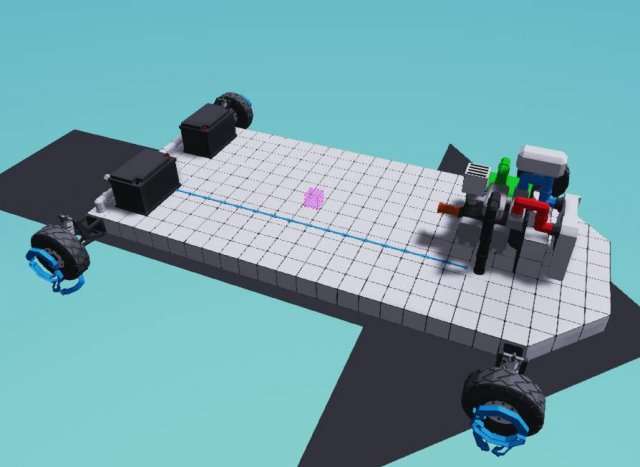
Well, worry no more and read on. We will tackle this together.
Head into creative, pick any of the mainland or Terminal Spycakes’ airfield as your starting point. You can make a car of your own, or grab the workshop link below (recommended).
Why a car instead of a boat? A boat generally can do with just a single gear setting, and a simple 3-speed car teaches you more.
Getting That Racing Beast to Run
Simply, connect the power output of the engine to the rear wheels. I personally like color coding my pipes, it makes them much easier to troubleshoot and toy around with if needed.

In the case you downloaded my absolute racing beast, make sure to slap on a driving seat and wire it up yourself as you like. Just leave the centerline clean, as that’s where the magic will happen, then take it for a test drive. I also recommend hooking up some dials. RPS and Temperature at the minimum
So what’s happening here? Let’s make a few notes:
- You have to hold the ignition down for a little while for the wheels to spin fast enough to get to speed.
- While it gains speed slowly at full throttle, eventually the wheels spin out and start powersliding making it difficult to control if you just give it enough power (this happens because the engine gains significantly more power output for each RPS it puts out).
- The engine is using a lot of fuel.
- There is no clutch/neutral (we can handle this later).
- You can’t go backwards.
How do we fix some of these for the time being and make it not suck?
Simple answer! Gut the power for the time being. Like this, you absolute madlad:
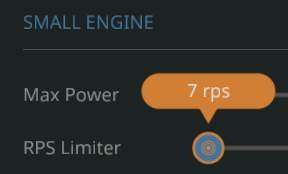
You have fixed the whole “having too much power” issue, skidding issue and all that, but the car is too slow. What do?
Gearboxes!
Metal Gearboxes?!
I’m subverting more expectations than Ruin Johnson here. Gearboxes, in a gearbox tutorial? Who saw that coming? Not me, that’s for sure, and i’m writing this thing!
“But wait, you beautiful, smart, filmatic, regal and all-around wonderful person who would do no wrong, you haven’t explained anything about gearboxes yet!”, – you say, with an incredulous expression on your face.
Just hold on, sport! Now is the time for action! …and explanation, too. Get your reading hat on, here’s some notes:
Since we can accelerate at a reasonable pace, we have a good first gear at 1:1 gearing. 1:1 (read: “one to one”) gearing means that the driveshaft (the orange power pipe’s contents) makes one rotation for every rotation the engine’s shaft makes. Simple, right?
Here are other 3 types of gears:
- 2:1 – For every 2 rotations the engine’s shaft makes, the driveshaft rotates 1 time.
- 1:2 – For every 1 rotation the engine’s shaft makes, the driveshaft rotates 2 times.
- 1:-1 – For every 1 rotation the engine’s shaft makes, the driveshaft rotates once the opposite way.
As you can probably figure out, the last one is a reverse gear. It can also be marked as -1:1. There are other gear values in gearboxes, but they work the exact same way as described above, they’re just different values, i.e. 2:3, which is the same as 1:1.5.
“Give me pictures i’m getting bored”, you cry out. Place a gearbox as shown.
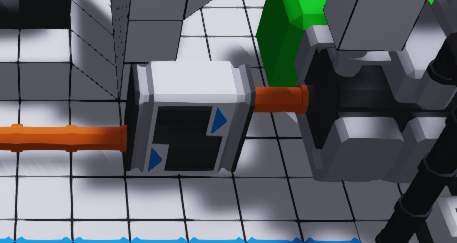
So you’ve probably noticed those arrows. The gearbox ratios are always marked one way in the game. They’re marked as 6:5, 3:2, 9:5 and so on, but based on the way the arrows are pointing, they can actually be 5:6, 2:3 and 5:9. (explained below)
Now select the gearbox, and set its ratios as follows. This will be our reverse gear.

Now wire up the electrics, and either a physical TOGGLE button or one of the seat buttons in toggle mode to the gearbox, and test it out. As you can probably expect if you know anything at all about cars, doing a reverse gear change at speed will kill the engine (in a real car it would destroy the gearbox as well).
The super important part
When the arrows are pointing toward the engine, you are increasing the rate at which the driveshaft behind the gearbox spins.
The opposite is also true. So why would you want to ever reduce the amount the driveshaft turns?
There are 2 things at play with gearboxes: Power, and torque. Power is essentially the speed that the driveshaft can turn with in the simplest explanation, and torque is the strength at which it is being turned at. A heavy machine may require significant downgearing (that is, running it at 3:1) to even get it to move!
Gearboxes are also not fully efficient. They eat up 5% of the power put through them. They are still very much worth it though.
And finally: Gearbox ratios stack multiplicatively. This means 2 gearboxes after eachother that have 1:3 become a 1:9 gearing.
Stop Saying So Much Stuff and Build Already!
Ok, you’ve gone through so much text, let’s build some.
I will not refer to the reverse gearbox at all. “first gearbox” is the first one after the reverse.
Build this, and electrically wire it up

For the first gearbox (arrows pointing toward engines), the first ratio is 2:1, and the second is 1:1, for the second they are 1:1 and 2:3. This means we now have gears for 2:-1 (reverse), 2:1, 1:1 and 2:3. You should know how if you read the important part. Note that i’m writing these ratios as they are, not as they’re represented in the game. We also have combination gears 1:-1, 3:4, 3:-4, and 2:-3. Let’s not use those, however.
Build or wire one switch for each of your new gears and go for a test drive, changing gears as you drive around (not the reverse, though!)
Since the first ratio of your gearbox is now 2:1, we have a starting gear much lower than before.
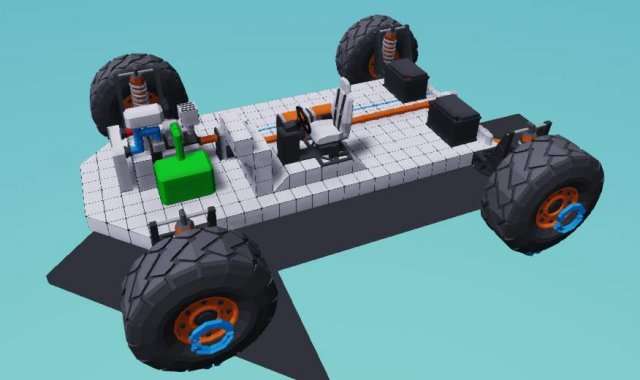
You notice at a very respectable speed at top gear we’re using relatively little fuel, and the engine is running cool.
Let’s swap into bigger tires. Replace all your tires with 7×7 (suspension) and rewire them. This is the reason we installed a proper starting gear.
To do this, you have to lift up the car with the move button located in the top row. Take the thing for a ride
Notice that it takes much longer to get to full RPS even at the lowest gear.
Drop down your first gear ratio to 3:1, and the second (previously 1:1) to 2:1 and increase the max RPS engine to 15. Now take it for a spin again! Your gears are now -3:1, 3:1, 2:1 and 5:3.
You can probably tell that we can fit 15 RPS rather easily with the first gear, but not the second, which peaks out at around 13 if we don’t turn, and the engine can’t handle the third.
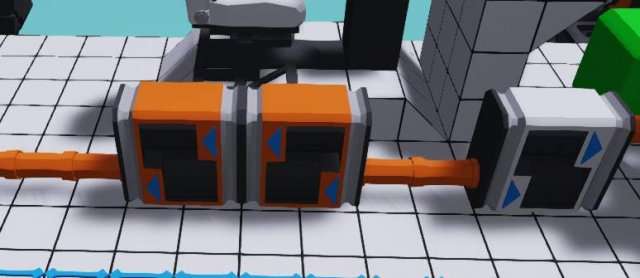
Remove the gearbox and put down another, with the arrows pointing the same way as the first. Put 2:1 as its first ratio, and leave 1:1 as its second. Our gears now are : -6:1, 6:1, 3:1, 2:1.
But changing these gears is a bother, isn’t it? If only there was some sort of a… clutch.
The Japanese for Clutch Is クラッチ, You Know It’s a Loanword Because It’s Written in Katakana
Listening to Eurobeat is strongly recommended for this, even if it doesn’t have anything to do with drifting or downhill racing.
A clutch is technically a second “throttle”, it allows the engine to rev up without engaging any sort of a drive. We will make a very simple clutch in this part, as well as some simple electronics.
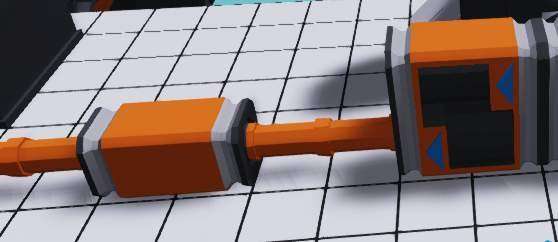
Place the clutch between the last gearbox and the wheels, then wire it up with electricity.
Clutches start their values at 0, and peak out at 1 (essentially 0 is 0%, 0.2 is 20% and so on). Using clutches with a static value you can tell it to share only a portion of the engine’s power elsewhere. This can be useful in case you want to give, say, 40% of the engine power to the front wheels and 60% to the rear wheels like in some race cars. (Though not with this engine with these huge wheels)
Electronics!
AKA microcontrollers. These can quickly become complex, but let’s KISS (keep it simple, stupid). I won’t be going through a microcontroller tutorial here, but it should be easy enough to follow without prior knowledge.
We need the microcontroller to have:
Digital signals (on/off):
- 2 inputs (gear up, gear down).
- 3 outputs for the gears (reverse, gearbox 1, gearbox 2).
Analog Signals (number):
- 1 Output for clutch.
- 1 Output for current gear (this can also be composite gear to be read out of instrument panel).
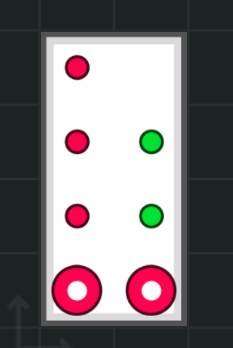
Make a microcontroller as described above, name it as you like (gearshifter is OK) and maybe give it an icon. The layout is simply for an example, you should name the inputs and outputs sensibly. Descriptions are not a necessity.
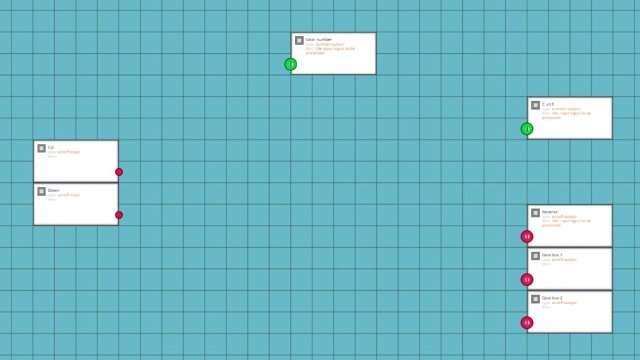
Spread out your things logically in the layout so it’s easier to work with. Now let’s think some simple logic stuff:
- We will be having push signals (not toggled on/off) to change gears.
- We need to have something that deals with the number logic of the gears (-1, 0, 1, 2, 3).
- We need to compare numbers and control things according to that.
If you know anything at all about logic gates/electronics, this should be extremely easy for you. For everyone else…
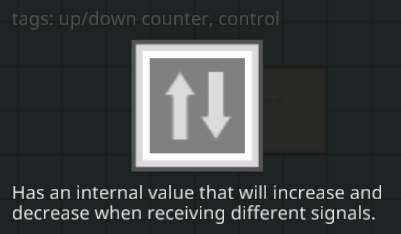
Our main workhorse already exists. The up/down counter does almost everything we need to do anyway. Put down an up/down counter in the middle of all of those electronics, wire the up signal to the up signal, down signal to the down signal, and wire the number to the gear number output. Then apply the following settings to the counter.
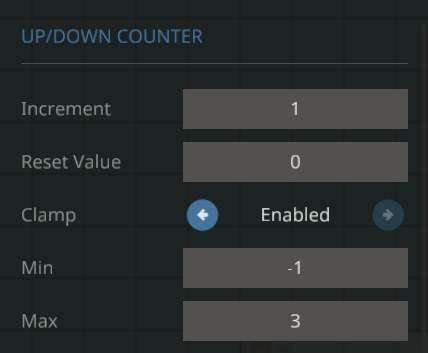
As you notice, there is also a “reset” input, this can, in the future, allow us to change to neutral if you wish, but that’s a modification you can do yourself later.
Now let’s deal with the clutch.
We want the clutch to be 0 at gear 0, and 1 at anything else.
We need:
- 2 Constant number (to compare the number, and to supply 1 to to the switchbox).
- Equals (the logic for comparison).
- Numerical switchbox (for changing between 0 and 1 for the clutch).
Make the needed components and wire them up as follows:
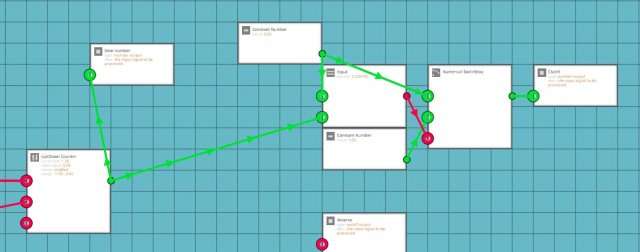
This will make it so that when the value of the up/down counter (our gear) is at 0, the numerical switch will be on, and output 0 to the clutch, which will mean our driving wheels are disengaged. On anything else than 0, the clutch will have value of 1.
The other bindings will be much more simple.
We need:
- 3 equals (to compare -1, 2 and 3).
- 3 constant numbers (to be compared against).
- 1 “OR” to keep the first gearbox in gear for the third.
Lay them out as follows:
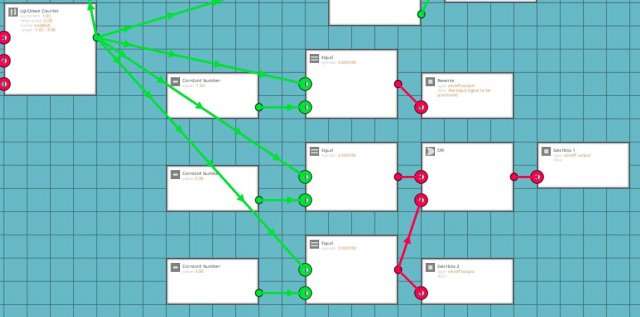
Finally, we have one last thing to do. The only shortcome of up/down counter is its sensitivity. We can deal with this by doing the following:
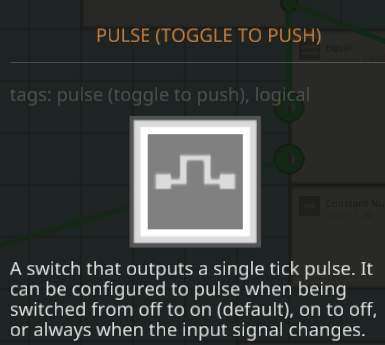
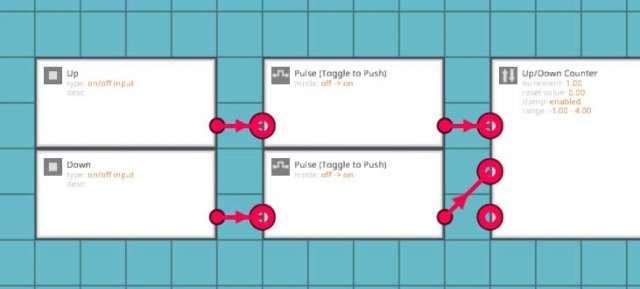
The pulse forces the input to be understood as one single touch, no matter how long you hold the button down.
We now have everything for a very simple electronic gearbox, the basis of this is the general basis of any gearbox. Save your microcontroller, and then slap it down on the car. If you haven’t made a microcontroller before, they can be found at the bottom of the component list.
Wire the first gearbox to the rearmost gearbox, the one that changes between 1:2 and 1:1 and the second gearbox to your other gearbox. Wire the reverse to the reverse gearbox, and wire up the clutch control. You can wire the gearbox controls as you like, and use any way you want to display the gear number (be it dial, digital display, or anything you want). Here’s how mine is wired at this point:

And, that’s all! You’ve done it! You’ve gotten through my waffling, meandering wall of text and managed to somehow come out on top and make a functional gearbox attached to a car! Hopefully this has left you with some ideas on how to improve the current design of the gearbox electronics and other ideas like that.
Linear Gearbox Design

Pros
- A lot of gears with very few gearboxes.
- Relatively simple electronics (at low amount of gears).
- Takes very little space.
- Clutch is technically optional.
- Easy layout.
Cons
- Gearboxes being 95% efficient eats up a good amount of power.
- Having a large number of gears can be an absolute headache.
The example picture has a whopping 2³ (2 to the power of 3) amount of gears, that’s an 8 whole gears in a compact package. The downside, 3 gearboxes means you’re getting out 85.7% of your engine’s potential. This is generally an acceptable overhead if you’re having issues with space or generally want a smaller form factor.
Parallel Gearbox Design
A parallel gearbox works by having 2 gears for each gearbox. Only one gearbox is engaged at any one time(unless you have gears that are larger than 3:1 or 1:3 of course!), the progression of clutches can be as follows (see image below):
- Clutch 1: Reverse, G1
- Clutch 2: G2, G3
- Clutch 3: G4, G5
- Clutch 4: G6, G7
Pros
- Logical 2 gears for each gearbox.
- Simple electronics with a significant amount of gears.
- Only one (set) of gearbox(es) being active at once limits efficiency drain.
- Easily scalable without having to rethink all your other gears.
Cons
- Larger electronics (every gearbox also needs at least one clutch output).
- Takes a significant amount of space.
- Multiple clutches are necessary.
There are 2 main designs of paraller gearboxes.
Side-by-side bulk design:
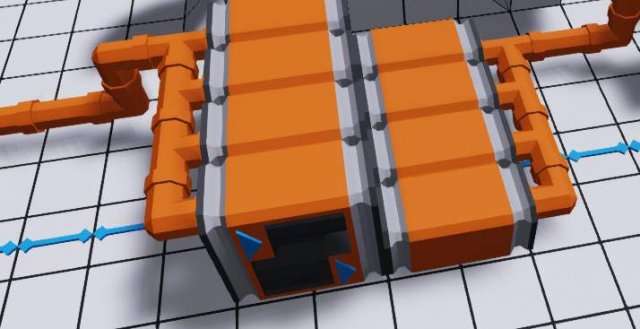
“Snaking” bypass clutch design:

This had to be colorcoded a bit. Red colored boxes are the gearboxes, cyan (blue) are the clutches leading into the gearboxes, and yellow is the clutches on main power pipe. There are a few pros and cons specific to this design:
Pros
- Allows 100% power delivery on the additional, free 1:1 gear.
- Allows spreading out the gears instead of having them in one block.
Cons
- Takes even more total space than the bulk design.
- Slightly more complex electronics, requiring output for the bypass clutches as well.
Tips & Tricks
The bypass reverse
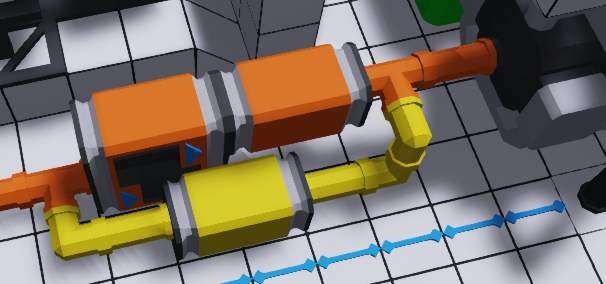
This setup allows a conventional reverse gear while bypassing the gearbox itself otherwise so the gearbox doesn’t apply the 5% penalty to power delivery.
Electric reverse
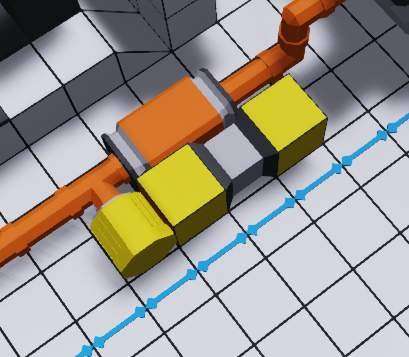
This setup disables the main engine from providing power to the drivetrain and toggles a relay which’ provides power to the electric motor. Keep in mind that electric motors are unaffected by gearboxes other than for their penalties, so this should be behind all other gearboxes.
Alternator / generator
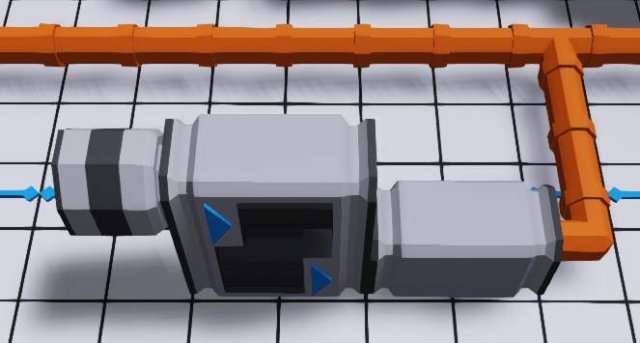
This setup allows you to adjust the clutch pressure (either manually or via electronics) that takes some of the engine power to generate electricity. It’s generally considered a good idea to automate this to keep your battery above 80-85% as electric motors start losing a significant amount of their power output.
A great gear ratio for using a small engine only to produce electricty is somewhere between 6:1 and 8:1 This can be achieved by having 2 gearboxes, one of which is 1:3 and one of which is 2:5, which produces a ratio of 2:15, or 1:7.5.


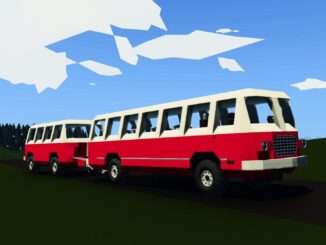
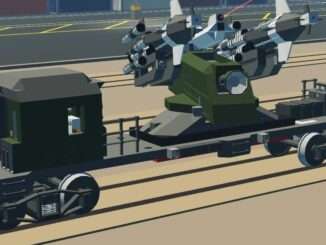

Be the first to comment